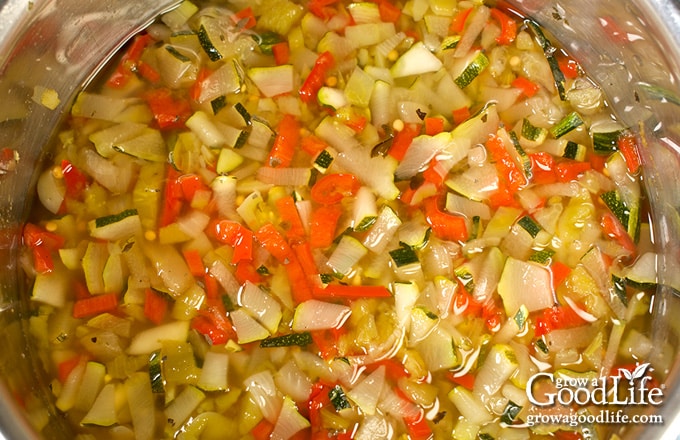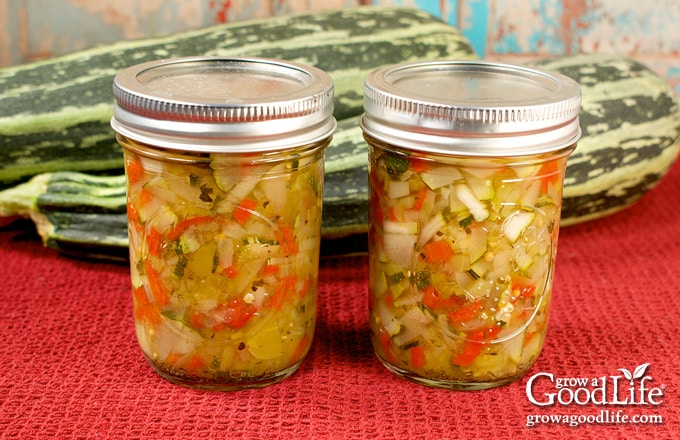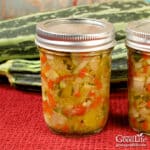Zucchini Relish Canning Recipe
This post may contain affiliate links, which means that I may receive a commission if you make a purchase using these links. As an Amazon Associate I earn from qualifying purchases.
Zucchini relish is a great way to preserve the summer glut of zucchini from your vegetable garden.
In this recipe, zucchini is combined with bell peppers, and onions for a sweet and slightly tart flavored relish that will dress up your hamburgers, hot dogs, sandwiches, and picnic salads.

If you’re like most gardeners, once summer arrives, you probably have an abundance of zucchini and summer squash coming out of your garden. You may even have many large fruit that seemed to show up overnight. This zucchini relish is the perfect way to use those overgrown zucchini.
Tips for Making Zucchini Relish
Turning that big harvest into zucchini relish is a great way to preserve it to enjoy all year long. Although you may be sick of zucchini now, you’ll be happy to open a jar of zucchini relish later to add flavor to sandwiches, topping to fish, and as a side dish to roasted meats to help balance the richness of the meal. Here are tips for making zucchini relish:
Any Variety of Summer Squash
Any type of summer squash can be used this recipe, including zucchini, yellow squash, crookneck, round zucchini, zepher, pattypan, or any combination. When selecting summer squash for relish, choose firm fruit without soft spots, insect damage, or wrinkled skin.
Your Choice of Peppers
Any type of peppers can be used as long as the amount stays the same. I like mixing sweet yellow, orange, and red bell peppers to add a pop of color. Feel free to spice up the relish by adding a few hot peppers to the mix. Wear gloves when handling hot peppers so you don’t burn your hands.
Any Type of Onion
Any variety of bulb onion can be used in this recipe, including ones that taste sweet or pungent. Feel free to use red, white, yellow, and even sweet Spanish type, or Vidalia.
- Red have a mild flavor and are a great to use if you want a less oniony taste. The color will bleed after canning, and may add a pink hue to your relish.
- White have a pungent flavor that blends well with the other ingredients. The sharp onion flavor mellows as the relish marinates in the pickling brine.
- Yellow are a great all-purpose onion that tastes harsh raw, but mellows after pickling.
- Sweet are also a good choice to help balance the tartness of the vinegar.
Use Vinegar with 5% Acidity
When pickling, use commercial vinegar with at least 5% acidity. The most common types used for canning are apple cider and distilled white vinegar:
- Apple cider vinegar is made from fermented apples and adds a slightly sweet apple flavor to pickled foods, but it will slightly darken the vegetables.
- White vinegar is clear vinegar made by distilling corn and rye. The flavor is sharper than apple cider vinegar. Choose an organic brand to avoid genetically modified corn.
Use Pickling Salt
Be sure to use pickling salt, also known as canning salt. Table salt contains iodine and anti-caking agents that can darken food and cause cloudiness and residue.
Measure the Vegetables After Chopping
This recipe calls for chopped vegetables. This means you will prepare and chop your vegetables as described in the recipe and then measure using measuring cups. Prepare the vegetables one at a time. Pulse the vegetables in food processor to chop, and add to a measuring cup as you go until you reach the required amount for the recipe.
Steps for Making Zucchini Relish
This simple zucchini relish recipe is from the Ball Blue Book Guide to Preserving. Keep the ingredient measurements the same to maintain the safety of this canning recipe, but feel free to mix and match the types of summer squash, onions, and peppers to add slightly different flavors and colors.
If you are new to canning or haven’t canned in a while, it may be helpful to review this article on water bath canning at the National Center for Home Food Preservation website. A more detailed and printable recipe can be found at the bottom of this article, but these are the general steps for making and canning zucchini relish:
Step 1: Gather Your Kitchen Equipment
You’ll need:
- Food Processor or knife and cutting board
- Measuring cups
- Water bath canner with canning rack
- 8 half pint canning jars
- Canning lids and bands (new lids, bands can be reused)
- Canning tools: canning ladle, funnel, and bubble popper
- Plus basic kitchen supplies such as large prep bowls, large pot, large spoon, large colander, and clean kitchen towels.
Step 2: Prepare the Vegetables
The ratio of ingredients is important to maintain the proper balance of acid in this canning recipe. Wash, prep, and chop each vegetable first, and then measure with a measuring cup. Chop all vegetables into the same sized pieces, using a food processor or knife. This will ensure you have the correct proportions.
- Zucchini: Wash the zucchini well to remove any residue and soil. Trim and discard a 1/4-inch slice from both ends of the zucchini. The blossoms contain an enzyme that can cause soft pickles, so it is important to remove this. Cut the zucchini in half lengthwise and scoop out the seeds. Chop and add to a measuring cup until you reach the required amount. Add the chopped zucchini to a large prep bowl.
- Peppers: Wash the peppers well. Cut them in half and remove the stems and seeds. Chop, measure, and add the peppers to the bowl.
- Onions: Peel, trim ends, chop, measure, and add to the bowl.
Step 3: Soak the Vegetables in Salted Ice Water
Soaking the vegetables in salted ice water for several hours helps the texture and flavor of your finished relish. Sprinkle canning salt over the vegetables, and toss to combine. Cover with crushed ice or ice cubes and water and let stand for 2 hours.
Step 4: Prepare the Canning Equipment
Once the vegetables almost finished soaking, prepare the jars, set up the canner, and organize your work area.
Wash your canning jars, lids and bands, and canning tools with warm, soapy water and rinse well. Look the jars over carefully, and eliminate any with chips and cracks. Set lids and bands aside until you are ready to use them.
Place the canner on the stove and insert the canning rack. Set the jars in the canner, add water to cover, and simmer (180˚F) for 10 minutes. Keep hot until you are ready to fill them.
Step 5: Make the Relish Brine
Drain and rinse the zucchini mixture well with cold water to remove the extra salt.
Add the sugar, celery seed, mustard seed, and vinegar to a large stockpot. Bring the pot to a simmer, and then add the rinsed vegetables to the pot. Stir to combine and simmer (180˚F) for 10 minutes.

Step 6: Can the Relish
Spread a dry kitchen towel on the counter. Use the jar lifter to remove a hot jar from the canner, drain, and place on the towel. Keep the remaining jars in the canner, so they stay warm.
Place the canning funnel on the jar, and ladle the hot relish into the jar while leaving 1/2-inch headspace. Run the bubble popper through the jar to release any trapped air bubbles. Adjust the headspace again if needed.
Wipe the rim with a damp towel to remove residue. Center a lid on the jar, add the band, and screw it on until fingertip tight. Place the jar back into the canner, and repeat with the rest of the jars.
Adjust the water level so it is covering the jars by two-inches, cover the canner, bring it to a boil, and process the jars in a boiling-water canner for the times indicated in the recipe below.
Once processing time is complete, remove the jars, and let them cool undisturbed for 12 to 24 hours. After cooling for at least 12 hours, test the seals. Refrigerate any that did not seal, and use up within a week.
Wash the jars with warm soapy water, dry, label and date the jars, and store in a cool, dark location for 12 to 18 months. Wait several weeks for the relish to develop its flavor before opening a jar.

Zucchini Relish Canning Recipe
Ingredients
- 4 cups chopped zucchini
- 2 cups chopped bell peppers
- 2 cups chopped onions
- 1/8 cup pickling salt
- 3 1/2 cups cane sugar
- 1 tablespoon celery seed
- 2 teaspoons yellow mustard seed
- 2 cups apple cider vinegar 5% acidity
Instructions
Prepare the Vegetables:
- Add the chopped zucchini, peppers, and onions to a large bowl.
- Sprinkle salt over the vegetables and toss to combine. Cover with crushed ice or ice cubes and water and let stand for 2 hours.
Prepare your Canning Equipment:
- Wash your jars, lids, screw bands, and canning tools in hot soapy water. Rinse thoroughly to remove all suds. Set aside to air dry on a clean kitchen towel.
- Place the jar rack into water bath canner, place jars in the canner, and add water to cover. Bring the canner to a simmer (180˚F) for 10 minutes, and keep the jars hot until you are ready to fill them.
Make the Brine:
- Drain the vegetables and rinse well to remove the extra salt.
- Add the sugar, celery seed, mustard seed, and vinegar to a large pot. Bring the pot to a simmer (180˚F) and then add the drained vegetables to the pot. Stir to combine and simmer for 10 minutes.
Can the Zucchini Relish:
- Lay a dry kitchen towel on the counter. Use the jar lifter to remove a jar from the canner. Drain the water back into the canner, and place on the towel. Keep the remaining jars in the canner so they stay hot.
- Use the canning funnel and ladle to fill the jar with hot relish, leaving 1/2-inch headspace.
- Wipe the rim to remove any residue, center a lid on the jar, and screw on a band until it is fingertip tight. Use the jar lifter to place the jar back into the canner, and repeat with the remaining jars.
- Once all the jars are in canner, adjust the water level so it is two inches above the jar tops.
- Cover the canner and bring to boil over high heat. Once water boils vigorously, continue boiling for 10 minutes at altitudes of less than 1,000 feet. Adjust processing time for your altitude if necessary (See Notes).
- When processing time is complete, turn off the heat, and let the canner cool down and settle for about 5 minutes.
- Spread a dry kitchen towel on the counter. Remove the cover by tilting lid away from you so that steam does not burn your face.
- Use the jar lifter to remove the jars from canner and place on the towel. Keep the jars upright, and don't tighten bands or check the seals yet. Let sit undisturbed for 12 to 24-hours to cool.
- After 12 to 24-hours, check to be sure jar lids have sealed by pushing on the center of the lid. The lid should not pop up. If the lid flexes up and down, it did not seal. Refrigerate jar and use up within a week.
- Remove the screw on bands and wash the jars. Label, date, and store in a cool, dark place for 12 to 18 months. Allow at least 3 to 4 weeks for the relish to develop its flavor. Once the jar is open, refrigerate and use up within a week. Yields 8 half pints.
Notes
Nutrition
This recipe was originally published August 23, 2009. It has been reviewed and updated with new photos and additional information.
You May Also Like:
- Other Ways to Preserve Zucchini
- Bread and Butter Pickles Canning Recipe
- Sweet Cucumber Relish Canning Recipe
Good planning is key to a successful vegetable garden
Whether you are new to growing your own food or have been growing a vegetable garden for years, you will benefit from some planning each year. You will find everything you need to organize and plan your vegetable garden in my PDF eBook, Grow a Good Life Guide to Planning Your Vegetable Garden.



can I freeze the chopped zucchini until the rest of the garden is ready and defrost/drain for a day or so?
Roxie, Unfortunately, frozen zucchini cannot be used for any home canning recipes. Freezing affects the texture, and draining will alter the pH, making it unsafe for canning. Instead, you can freeze the zucchini and use it in other recipes like soup, pasta, or zucchini bread.
Can I use Himalayan pink rock salt ?
Erica, It’s generally recommended to use pure canning or pickling salt in canning recipes because it doesn’t contain additives that can potentially affect the taste or appearance of your preserved foods. Himalayan pink rock salt, while natural and flavorful, may have impurities that can lead to cloudiness or off flavors in your canned products. For the best results, it’s advisable to stick with canning or pickling salt in your canning recipes.
I keep coming back to this recipe year after year. I was confused with the updated photo but this is definitely it. I prefer the previous picture posted and make mine chopped finer like that one.
If I have too much liquid I will exclude it when filling the jars or just drain my spoonfuls when serving it out. Thanks for this recipe.
Hello! How would you modify this recipe to uae a pressure canner instead? Thisnmay be an ignorant question – I am still learning the world of canning and preserving. 😊
Rosie, Not an ignorant question at all! This relish recipe is designed for water bath canning. There are no pressure canner recipes for pickles or relishes. The heat would be too high to get a quality product.
It’s great that you’re eager to learn about canning and preserving. When it comes to modifying canning recipes, it’s important to remember that these recipes are scientifically developed tested to ensure safety. Modifying ingredients or techniques might compromise the safety and quality of the final product. Instead, I recommend following canning recipes as written from trusted sources like Ball Canning, and the National Center for Home Food Preservation. This way, you can enjoy the best results without any risks. As you continue your journey into canning, you’ll discover a wide range of recipes designed to meet different canning methods, including pressure canning. Happy learning and canning 😊
Is it supposed to be liquidy? I simmered for 20 minutes and there’s still a lot of liquid. I’m never made relish before so wondering if that’s normal. Thanks.
Nicole, it’s normal for this relish to have a runny texture. To help troubleshoot, did you soak the vegetables in salted water and drain and rinse them well before adding them to the brine? Squeezing out as much liquid as possible can also help. The recipe calls for a simmering time of 10 minutes – be careful not to overcook the vegetables, as this may cause them to break down further and release more liquid. If you prefer a thicker consistency, you can always drain the excess liquid when you open the jar for serving. Hope this helps!
Hi, am making with an abundance of zuchinni. Do I have to water bath these? How long would they last jarred in fridge? Thanks
Hi Carolynn, It’s great to hear that you’re making zucchini relish with all the abundance of zucchinis. To answer your question, I highly recommend water bath canning the relish for safety reasons. The heat processing involved in water bath canning eliminates bacteria and makes the jars shelf-stable, allowing the relish to be stored safely at room temperature for an extended period. If you choose not to water bath can the relish, it can still be stored in the refrigerator, but its shelf life will be significantly shorter compared to properly canned jars. Without the heat treatment, the relish might last for a few weeks to a couple of months in the refrigerator, depending on the ingredients and storage conditions. If you’re going to take the time to make the relish, I encourage you to go the extra step of water bath canning. This will not only ensure its long-term safety but also allow you to enjoy your delicious zucchini relish throughout the year.
Thank you for the step by step instructions and options. I should have squeezed out the water, but recipe turned out great! I used crookneck squash and zucchini from my garden, banana peppers, one jalapeno, and a tsp of crushed red peppers (pizza peppers). Yummy, sweet heat. Filled seven jelly pints.
Stacy, I’m glad the recipe turned out great for you, and your combination of garden-fresh vegetables sounds delicious. You can also drain out any extra liquid when you open a jar to adjust the consistency of the relish to your liking. Enjoy your flavorful homemade relish!
I don’t have cane sugar, just regular white sugar. Are the measurements the same?
Shaun, Yes, just use regular white sugar. White sugar can be derived from either sugarcane or sugar beets, and both variations are commonly available in granulated form. So feel free to use granulated white sugar, as it will work perfectly well for the recipe.
I am diabetic and have taken sugar or sweetners out of my diet. I have been looking for canning recipes that do not include sugars or sweetners. I am having trouble finding recipes without the sweet. Can you suggest where to look for these types of recipes without added sugar or sweetners? Thank you Nancy
Nancy, Unfortunately, there aren’t a lot of tested recipes for canning without sugar. Jams, jellies, and fruit spreads rely on sugar for gelling and preserving. However, in other recipes, such as sauces, salsas, pickles, and relish, sugar is used for flavor, not as a preservative. It can be left out, but you will find that omitting sugar affects the color, texture, and taste of pickled foods. I suggest trying small batches to see if you like them.
I followed the recipe but only got 5 half pints out of it, all with a significant amount of liquid at the bottom. If I double the amount of vegetables without doubling the brine, does that throw the recipe out of balance?
Len, I use this recipe frequently, and every time the number of jars is different for every batch. The yield will vary depending on the moisture in your vegetables and the size of your pieces. To help reduce some of the extra liquid, after rinsing and draining the vegetables, use your hands to press the mixture and squeeze out as much moisture as possible before adding it to your brine. The recipe has been lab tested for safety by Ball. As long as you followed the recipe, your jars are safe for storing.